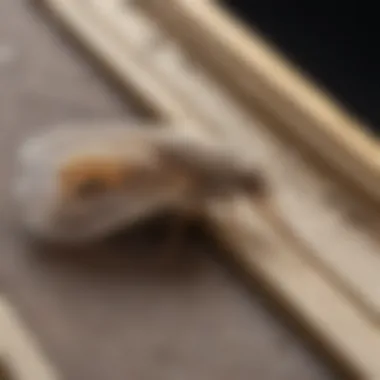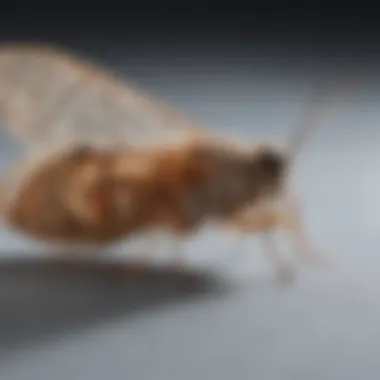Understanding Casemaking Clothes Moth Traps: Efficacy and Utilization


Intro
In the realm of household pests, casemaking clothes moths are often overlooked despite their capacity to cause significant damage to textiles and garments. Understanding these pests and the traps designed to capture them can be invaluable for homeowners. Although many people may not be aware of casemaking clothes moths and their habits, their presence can result in the degradation of valuable clothing items.
This article will provide an insightful exploration into casemaking clothes moth traps, evaluating their effectiveness and practical applications within pest management strategies. The examination will include the biology of these moths, the basic design principles of traps, and effective implementation methods. Our aim is to not only inform but also empower homeowners and pest management professionals to take proactive steps against potential infestations.
Understanding Pests
Definition of Pests
Pests are organisms that cause harm to humans, their property, or their food sources. In this context, casemaking clothes moths belong to a group of pests that primarily target textiles, particularly those made from natural fibers like wool, silk, and fur. These moths feed on fibers that contain keratin, leading to deterioration in clothing and textiles.
Importance of Pest Identification
Identifying pests can significantly affect the success of pest management solutions. Recognizing the signs of an infestation early can help homeowners take adequate measures before the situation escalates. Adult casemaking clothes moths are small, often less than a half-inch in length, and their larvae create silken cases that are attached to fabric. By observing these characteristics, one can better understand the nature of the problem and formulate a response.
Prevention Techniques
Home and Garden Preventative Measures
Preventative techniques are essential to safeguard your home from infestations. Some measures include:
- Regular Cleaning: Frequent vacuuming and dusting can help eliminate dust and fibers that attract moths.
- Storage Solutions: Use airtight containers for storing clothing, especially items that are seasonal.
- Natural repellents: Cedar and lavender can be effective in repelling moths.
Seasonal Prevention Tips
Seasonal changes can affect moth behavior. During warm months, keep windows closed or screened to prevent adult moth entry. Clothing that is not in use should be cleaned and stored properly. Additionally, inspect items before bringing them back indoors after summer vacations.
Eco-Friendly Pest Control Solutions
Overview of Sustainable Practices
With growing awareness about environmental issues, many homeowners seek eco-friendly pest control solutions. Sustainable practices focus on using non-toxic methods that are safer for both humans and pets. Examples include:
- Utilizing sticky traps that do not contain harmful chemicals.
- Making use of plant-based repellents that deter pests without toxicity.
Natural Remedies and Their Effectiveness
Natural remedies can serve as an effective part of pest control strategy. Essential oils such as peppermint and eucalyptus can deter moths when applied on cotton balls and placed in closets. Therefore, consider experimenting with these remedies while monitoring for effectiveness to manage your clothes moth issue.
"Understanding the biology of pests is the first step to effective control."
Ultimately, understanding the nuances of casemaking clothes moths and their traps can make a significant difference in maintaining the integrity of one’s wardrobe. As we explore the various traps available in detail, we aim to equip our readers—housewives and homeowners alike—with the knowledge necessary for proactive pest management.
Intro to Casemaking Clothes Moths
The study of casemaking clothes moths serves an important role in understanding and mitigating pest infestations that can plague homes. These pests, known scientifically as Tineola bisselliella, are often underestimated until they have caused significant damage to textiles. With their capability to consume wool, silk, and fur, recognizing their biology and behavior is crucial for effective pest management. Homeowners need to familiarize themselves with casemaking clothes moths to prevent long-term damage to valuable fabrics and clothing.
Being aware of the signs of an infestation and the environments that favor their presence allows for early intervention. This understanding can make all the difference, transforming a potential crisis into a manageable situation. Catching infestations early generally leads to less overall damage, thereby saving both time and effort during pest control.


Key elements to consider include their habits, environmental conditions, and the comprehensive measures that can be taken to counteract their presence. By informing homeowners about these aspects, the article aims to equip them with the knowledge necessary to effectively use trap systems designed specifically for these moths.
Biology of Casemaking Clothes Moths
Casemaking clothes moths are small, only about 8 to 10 mm in length. They possess a characteristic golden color mottled with dark brown. This coloration helps them blend seamlessly with the textiles they infest. Understanding their biology is vital for identifying effective control measures. The adults are primarily nocturnal, preferring dark areas for mating and laying eggs.
The females are known to lay between 30 and 300 eggs throughout their lifespan. Once these eggs hatch, the larvae emerge and feed on keratin, a protein found in animal fibers. This feeding behavior leads to the characteristic damage many observe, marked by holes in clothing and other textiles.
Adult moths feed very little, focusing primarily on reproduction. Consequently, it is the larvae that pose the most significant threat to apparel and upholstery.
Factors such as humidity and temperature affect their lifecycle dramatically. Typically, casemaking clothes moths thrive in warmer, darker spaces, making closets and attics prime locations for potential infestations.
Lifecycle and Behavior
The lifecycle of casemaking clothes moths consists of four stages: egg, larva, pupa, and adult. Eggs are laid in the vicinity of food sources, which are mainly natural fibers. Once the larvae hatch, they begin to consume the fabric around them, often retreating into casements for safety. These casements are made from the same material they consume, providing them with a protective home.
This behavior indicates a highly adaptive strategy, allowing them to evade detection while maximizing their food supply. The larval stage is when the most damage occurs, lasting for about 2 to 4 months, though it may last longer depending on environmental conditions.
As larvae develop and approach pupation, they cease feeding and undergo a transformation process. This stage can last from several days to weeks, after which the adult moth emerges.
Understanding this lifecycle is fundamental in identifying optimal times for trap implementation. If traps are used during peak larval activity, they can significantly enhance control efforts. Overall, a deeper understanding of their lifecycle and behavior aids in creating a more effective approach to pest management.
Moth Damage: Identifying Infestations
Identifying infestations caused by casemaking clothes moths is crucial in managing and preventing damage to valuable fabrics and garments. Awareness of specific signs of infestation and knowing which areas are most affected can minimze the potential for costly repairs or replacements. Furthermore, early detection enables homeowners to implement corrective actions sooner rather than later, ultimately safeguarding their personal belongings as well as the environment.
Signs of Infestation
Detecting the presence of casemaking clothes moths often begins with recognizing the signs of their activity. Some significant indicators include:
- Visible larvae: Spotting small, white to pale yellow caterpillars is a clear sign. These larvae typically feed on the fibers of clothing, often near seams or in folds of fabric.
- Adult moths: The adult casemaking clothes moth is small, usually measuring around 5 to 8 mm long. They are often golden to brown in color with a noticeable sheen. Observing these moths, particularly around infested areas, is a strong indicator of a problem.
- Silk cases: Larvae construct protective silk cases using fabric fibers. Finding these cases indicates that moth larvae have been active in the area.
- Damage patterns: Look for irregular holes or frayed edges in clothing. Such damage often results from feeding larvae.
These signs may manifest in diverse forms in different environments. It is essential to remain vigilant and regularly inspect stored items and closets.
Common Areas of Damage
Casemaking clothes moths tend to infest specific spaces where natural fibers abound. Recognizing where these pests are likely to cause damage can help homeowners take proactive measures. Common areas include:
- Closets and wardrobes: Dark and undisturbed spaces found in closets provide an ideal breeding ground for these pests. Stored clothing, especially those made from wool, silk, or cashmere, are particularly vulnerable.
- Attics and basements: These areas often house storage boxes filled with older clothes, blankets, and carpets. Homeowners should check these locations regularly to prevent infestations.
- Furniture: Upholstered items, including sofas and chairs, may harbor eggs and larvae within their seams or under cushions. Regularly inspecting and vacuuming furniture can contribute to pest management.
- Laundries: Residues of lint and fabric scraps can accumulate in laundry rooms, providing food sources for larvae. Keeping this area clean is important.
By focusing on these commonly affected areas and understanding the signs of infestation, homeowners can position themselves at an advantage, allowing them to respond quickly and effectively.
"Identifying the signs early not only saves you money but also protects your precious belongings from irreversible damage."
By maintaining awareness and conducting regular inspections, the risks associated with casemaking clothes moth infestations can be significantly reduced.
Understanding Moth Traps
Moth traps serve a critical role in controlling infestations of casemaking clothes moths. Understanding the various aspects of these traps is essential not only for effective pest management but also for the protection of valuable materials in homes. Casemaking clothes moths target fabric materials, which can lead to considerable damage. Utilizing moth traps can significantly aid in monitoring and controlling these pests. This section explores how moth traps function and the different types available.


Mechanism of Action
The mechanism of action of moth traps relies primarily on the use of pheromones. These substances are good at attracting male moths, which helps to interrupt the mating cycle. Once the male moths are caught, it reduces the chances of females laying eggs, thus inhibiting future infestations. Most traps are designed with a sticky surface that captures these males effectively. This is key because it is the males that are drawn to the pheromone scent. By understanding this dynamic, homeowners can utilize traps more effectively by placing them in strategic locations where moth activity is noted.
"The use of pheromones in traps is not just clever. It is a scientifically-backed method to disrupt the lifecycle of the pests."
Another important aspect is that these traps often have a long-lasting effect, extending their efficacy over a period of weeks. Homeowners can thus monitor moth populations more efficiently without needing to replace traps frequently. Understanding how these pheromone traps work is a fundamental to effective pest control.
Types of Moth Traps
There are several types of moth traps available, each serving unique needs and preferences. Here are some common types to consider:
- Pheromone traps: These are the most common and are designed to capture male casemaking clothes moths through the lure of pheromones.
- Sticky traps: Generally effective for various insects, these traps use a sticky surface to catch moths that happen to fly into them, regardless of whether they are male or female.
- UV light traps: These traps utilize ultraviolet light to attract moths. While not as targeted as pheromone traps, they can still capture various moth species.
- Reusable traps: Some options allow for traps to be cleaned and reused, which can be more sustainable and cost-effective in the long run.
Choosing the right type of trap often depends on the level of infestation, locations of potential risks, and the specific needs of the household. It is worth assessing which trap aligns with those needs for the best outcomes. By understanding the types of traps, homeowners can make informed decisions regarding pest management strategies.
Evaluating Trap Efficacy
Understanding the efficacy of casemaking clothes moth traps is vital for effective pest management. These traps offer a practical solution, but their success depends on various factors. Homeowners and pest management professionals alike benefit from comprehending how well these traps work against infestations. By evaluating trap efficacy, users can optimize their strategies for dealing with casemaking clothes moths and, ultimately, protect their belongings more effectively.
Effectiveness Against Casemaking Clothes Moths
Casemaking clothes moth traps are specifically designed to combat the threats posed by these pests. The traps utilize pheromones that attract male moths, disrupting the breeding cycle. This interruption is crucial in controlling the population. Studies have shown that when these traps are used correctly, they can considerably reduce the number of moths. Some traps report a reduction of up to 80% in captured moths within a specific time frame.
However, effectiveness can vary depending on several conditions. Environmental factors, such as the trap's location, also play an essential role in capturing these pests. Proper placement near moth breeding areas, such as closets and attics, enhances the trap’s effectiveness. It's important to monitor traps regularly, as accumulation of captured moths can affect performance.
Factors Influencing Success
Several factors influence the success of casemaking clothes moth traps. Understanding these is key in maximizing their potential:
- Placement: As mentioned, optimal placement enhances effectiveness. Traps should be set in areas with high moth activity.
- Trap Design: The design influences how well the trap works. Some traps have specific attractants that appeal to the casemaking clothes moths, making them more efficient.
- Duration: Leaving traps in place for longer periods can increase capture rates. Moth populations may fluctuate, and traps need time to intercept them.
- Monitoring: Regular checks are important to assess if the traps are functioning. Replace traps when they become full or lose their effectiveness.
"Monitoring and changing traps regularly is pivotal for maintaining their efficacy against casemaking clothes moths."
Taking these factors into account allows for a more strategic approach to moth management. As one integrates these elements, success rates will likely improve, and a clearer understanding of moth populations will develop.
Using Casemaking Clothes Moth Traps
Utilizing casemaking clothes moth traps is a crucial aspect of managing infestations effectively. Traps provide a targeted method to monitor and regulate moth populations. They allow homeowners to observe the presence of casemaking clothes moths without the need for harsh chemicals. By finding the right traps and placing them correctly, individuals can diminish moth activity and protect valuable textiles.
Traps serve not only as a control measure but also as a psychological tool. They can provide peace of mind when one knows that monitoring is actively occurring. This guide will detail important recommendations for trap placement, along with strategies for ongoing monitoring and maintenance.
Placement Recommendations
To achieve optimal results from casemaking clothes moth traps, proper placement is essential. Here are some recommendations:
- Identify At-Risk Areas: Pay attention to closets, attics, and basements. These areas often harbor clothing and textiles, making them prime locations for moth activity.
- Height Matters: Place traps at clothing height, where moths are likely to fly. Consider hanging traps on walls or from shelves.
- Avoid Obstructions: Ensure traps are not placed near other objects that could impede flight paths. Clear space allows for better catch rates.
- Use Multiple Traps: One trap may not suffice, especially in larger spaces. Distributing several traps throughout the affected areas can enhance detection and capture of moths.
- Change Locations: If a trap captures few or no moths, consider relocating it to a different area. Moths may prefer specific environments or may be less active in certain spaces.
Monitoring these factors can significantly improve the effectiveness of traps, ensuring they capture the highest number of pests.


Monitoring and Maintenance
Ongoing monitoring and upkeep are paramount to the success of casemaking clothes moth traps. Here are key considerations to keep in mind:
- Regular Inspections: Check traps at least every two weeks. Frequent inspections allow prompt responses to any increased moth activity.
- Replace as Needed: Traps should be replaced according to the manufacturer's guidelines, or sooner if they gather too many moths. A saturated trap loses its effectiveness.
- Keep Areas Clean: Regular cleaning around trap locations prevents the accumulation of dust and debris, which can interfere with their function.
- Log Captured Moths: Keeping a record of the number and type of moths caught can provide insight into infestation trends. This data helps to adapt pest management strategies appropriately.
- Be Mindful of Chemical Interference: If using other pest deterrents, ensure they do not compromise the attraction of traps. Chemical residues can diminish effectiveness.
"Ongoing maintenance will extend the life and usability of traps, while offering clear insights into moth activity within your home."
By following these strategies, homeowners can maximize the potential of casemaking clothes moth traps, creating a more effective pest management program tailored to their needs.
Complementary Pest Control Strategies
Complementary pest control strategies enhance the effectiveness of casemaking clothes moth traps. While traps play a vital role in monitoring and reducing moth populations, they are most effective when combined with practical preventive measures and sustainable practices. This section focuses on these important elements within pest management.
Preventive Measures
Preventive measures are crucial in keeping casemaking clothes moths at bay. Simple habits and mindful practices can significantly limit the risk of infestations. Here are some key strategies:
- Regular Cleaning: Vacuum regularly to remove eggs, larvae, and cocoons. Pay special attention to areas where natural fibers are stored, as these attract moths.
- Proper Storage: Store clothing, especially natural fabrics like wool and silk, in airtight containers. Using mothballs or cedar chips can also deter infestations.
- Humidity Control: Moths are drawn to humid environments. Using dehumidifiers in problem areas can make these spaces less inviting.
Implementing these measures creates an unwelcoming environment for casemaking clothes moths, reducing the chances of infestation before it starts.
Sustainable Practices
Adopting sustainable practices is not only beneficial for the environment but also for effective pest control. These methods focus on creating a balanced ecosystem that discourages pest infestations:
- Use of Natural Repellents: Many homeowners prefer using essential oils, like lavender and eucalyptus, as they can effectively repel moths when added to storage bags or used in cleaning.
- Integrated Pest Management (IPM): This holistic approach combines biological, cultural, and physical control measures. IPM takes into account the life cycle of pests and utilizes traps alongside other methods to maintain moth populations at manageable levels.
- Encouraging Natural Predators: Introducing monitoring-friendly natural predators, such as specific beetles, can help keep moth populations in check. This option provides balance without the use of synthetic chemicals.
By integrating these strategies, homeowners can not only maintain a moth-free environment but also contribute positively to ecological health.
Keeping an environmentally friendly approach not only helps in managing pests but also supports sustainability.
Combining casemaking clothes moth traps with these complementary pest control strategies significantly increases the chances of effectively managing infestations. Improved preventative efforts create a robust defense against these insects, resulting in a healthier living space.
Culmination
The conclusion of this article serves as a vital synthesis of the information discussed regarding casemaking clothes moth traps. It highlights the key elements of effectiveness, utilization, and the overall importance of understanding these tools in pest management strategies.
Casemaking clothes moths can be a nuisance for homeowners, leading to significant damage if left unchecked. Therefore, knowing how traps function and their strategic application can make a critical difference in managing infestations. The traps themselves function by attracting and capturing adult moths, which are responsible for laying eggs and perpetuating the cycle of damage.
Summarizing the key points presented earlier not only reinforces their relevance but also aids homeowners in making informed decisions about pest control. The integration of preventive measures, along with trap utilization, promotes a more comprehensive approach to managing pests effectively.
Summarizing Key Points
- Casemaking clothes moths pose a real threat to textiles and other materials in homes.
- Understanding their biology and lifecycle informs effective utilization of moth traps.
- Moth traps work by leveraging attractants to catch adult moths, reducing their population.
- Placement and monitoring of traps significantly impact their efficacy.
- Complementary measures, such as preventive strategies and sustainable practices, are essential for holistic pest management.
"Effective pest management requires a multi-faceted approach that combines knowledge of pest behavior with practical control strategies."
Future Considerations in Pest Management
As pest management continues to evolve, there are several considerations for homeowners regarding the future of dealing with casemaking clothes moths. First, as technology advances, more innovative traps may emerge that could enhance effectiveness. This includes better lures or improved design for easier monitoring by homeowners.
Second, the importance of research into more sustainable pest control methods cannot be understated. Homeowners should remain vigilant about adopting environmentally friendly practices that minimize harm to non-target species while controlling pest populations effectively.
Lastly, staying informed about new insights into moth behavior and ecology can assist homeowners in adapting their strategies to address any emerging issues more proactively. It is crucial to engage with ongoing education about pest management to ensure practices remain effective and relevant in the future.



